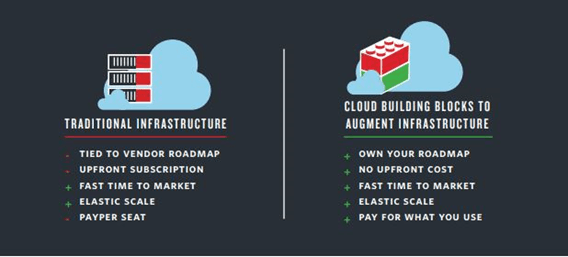What is a Cloud Contact Center?
Cloud contact centers make contact center software functionality that was previously only accessible through on-premise hardware available through the internet. A cloud contact center provides access to the tools and services businesses need to communicate in today's web-based world.
Until recently, existing contact center technology gave businesses limited options. Many companies got locked into expensive, on-premise contact center infrastructure that won't scale, because it was the best option available at the time.
However, cloud contact centers use the latest in communications technology to give businesses a modern alternative to on-premise contact centers. With a cloud contact center, companies don't have to maintain the additional redundant hardware and data center space required by an on-premise solution.

When your cloud contact center includes the global infrastructure for your business communications, you can get to market without building, deploying, and maintaining those complex services yourself. The cloud-based approach to the contact center delivers major advantages:
- Scale - you can expand usage needs on-demand, without additional time or expense to update hardware.
- Global reach - you don't need to negotiate with carriers in every country in which you do business. Cloud platforms allow you to buy on-demand phone numbersfrom around the world and deploy immediately.
- Improved reliability - by aggregating the requirements of tens of thousands of customers, cloud platforms offer greater reliability than what most can afford to implement independently.
- Elasticity - you can scale up and scale back down, responding to changing needs without penalty. Use what you need, when you need it.
- Cost control - you can prototype, build, deploy, and rapidly iterate with little or no impact on your operating budget. Without compromising quality, you'll likely experience significant cost savings.
By moving your communications from legacy, on-premise systems to cloud-based software, you can experience greater reliability, global carrier connectivity, and multi-function numbers. Here are the top 10 best practices to look for when choosing a cloud contact center provider:
- Uptime - you want to be sure your contact center will provide a highly reliable, quality connection wherever it's located in the world. Be sure to look for uptime that exceeds a 99.95% SLA.
- Distributed software layer - choose an option that provides a distributed software layer so you don't have to negotiate contracts with carriers, set up networking interconnections, or build algorithms for routing, monitoring, and failover.
- SIP Trunking - for agents who need a physical phone, choose a solution with an SIP trunking service that provides unlimited concurrent call capacity so you can connect SIP phones without deploying PBXs.
- IVR - be sure your contact center allows you to create greetings, build menus, and customize your IVR using the web languages you already know. You want to be able to A/B test and continually adapt your IVR to your customers' changing needs.
- Include SMS -nine out of ten users worldwide want to use text messaging to talk to businesses. Make sure your business can meet this demand.
- Web interface -WebRTC enables your agents to make or receive calls directly from a browser or CRM. This lets you gradually add additional contact center agents in new regions without capital expense or local hardware deployment; just plug them right in.
- Chat, Video, Click-to-call - take your customer interaction to a whole new level by allowing your customers to connect via chat, voice, and while they're browsing your website or app. Look for these options in the solution you choose.
- Attribute-based and omnichannel routing - choose a cloud contact center solution that can route tasks from all communication channels to the most qualified available agents, based on the attributes you define.
- Mobile customer care - look for a solution that enables you to connect with customers within your mobile app, even if you don't have an app yet.
- Call tracking and analytics - with the right call tracking and analytics, you can keep track of incoming and outgoing calls, measure the value of marketing spend, compile information about call times and agent performance, and much more.
Cloud platforms like Twilio allow you to control your own roadmap, so you can make the incremental upgrades you want on your own timeline, without downtime or upfront investment. Legacy and "off the shelf" call center software options come with a pre-defined roadmap. They offer specific features and a "one size fits all" approach that may not offer the flexibility you need to create the exact customer experience you want. With a cloud contact center, as your business goals change, you can adjust your technology to meet your new goals.